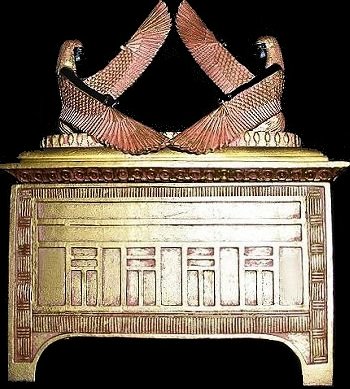Page 5 of 12
The Templars and the Ark of the Covenant

In the 1180s, the Crusaders discovered a sealed cave at the foot of Jebel Madhbah and frantically excavated it to find what they believed to be treasures from the time of the Old Testament. One of these was described as a golden chest. Could it have been the lost Ark?
It was at the foot of Jebel Madhbah, close to the Spring of Moses, that in the 1180s a group of English knights discovered a treasure that may have included the Ark of the Covenant.
According to the Arab chronicler Numairi, who wrote around AD 1300, in the 1180s these knights discovered a sealed cave at Jebel Madhbah where they found "treasures of pure gold, precious stones and a golden chest". There was no specific reference to the Ark of the Covenant, but the knight did claim that these were holy relics that had belonged to the ancient Israelites. Numairi describes the chest as being made from paneled gold with two winged figures on the lid which he describes as being similar to ancient statues that still survived in his native Egypt. Unfortunately, he does not give the dimensions of the chest, which may have been any size. If it was large, however, it does sound very similar to the Ark. In fact, according to the Bible the Ark was made shortly after the Israelites had left Egypt and, as they had been enslaved there for generations, their craftsmen may well have been influenced by Egyptian art.
So who exactly were these knights that discovered the treasure at Jebel Madhbah in the 1180s? The Knights Templar, or Templars for short, were originally monks of the Cistercian order who had taken a vow to fight for Christianity in the Holy Land. They became immensely rich from their conquests in the Middle East and used this wealth to found Templar monasteries throughout Europe. Called preceptories, these monasteries were both centers of religious devotion and training camps for these warrior monks. It was the founder of one of these preceptories in England, one Ralph de Sudeley, who was the responsible for building the crusader forts in Petra during the 1180s. In 1189 the Arabs re-conquered what is now southern Jordan and the Templars were forced to abandon the Wadi Musa and returned to England – evidently with the treasures they had found.
Had the Knights Templar stationed in the Wadi Musa really found the treasures from the Temple of Solomon that were hidden by Jeremiah in the sixth century BC? Had they found the Ark of the Covenant? In 2003 Graham Phillips decided to investigate.
The Crusader Treasure

Reconstruction of the chest discovered by the Crusaders in a cave at Jebel Madhbah in the 1180s. Although of Egyptian design, it was remarkably similar to the descriptions of the Ark given in the Bible.
Below Jebel Madhbah, to the north, lies a valley called Wadi Musa – Arabic for the "Valley of Moses". For years this valley was an important trade route through the Shara Mountains and by Roman times the splendid city of Petra had been built here. The city of Petra was annexed by the Romans in AD 106 and ultimately declined with the fall of the Roman Empire. By the time of the conversion of the Arabs of the area to Islam in the seventh century it was abandoned altogether. In the twelfth century, Crusaders from European countries such as France and England conquered Jerusalem and set up a Christian kingdom in what is now Israel. In order to protect Christian interests in the region, various orders of knights were founded and one of these, the Knights Templar, briefly occupied the ruined city of Petra and built a series of forts to protect the trading route that ran through the Wadi Musa.








